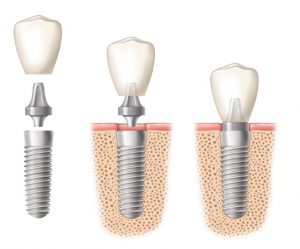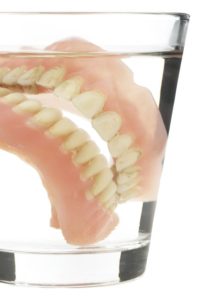Header logo
header top contact widget
Financing Options
Understanding Dental Implants & Their Benefits
Posted on Nov 03, 2020 by William J. Claiborne, DDS MS
When you lose a natural tooth, even one that isn’t visible when you smile, its absence causes a reaction that takes place below the gum line. Many people are unaware of what occurs – at first. When it becomes obvious, it leads to problems that are not only bothersome, they are detrimental to your overall health.
The absence of a tooth root in the upper or lower jaw bone is a loss of stimulation the bone mass where it was once positioned. These roots provide stimulation and nourishment that enables the bone to maintain a healthy mass. Without the presence of tooth roots, the bone begins to “melt away.” The term for this process is known as resorption.
Resorption begins shortly after the tooth root is removed. Once it begins, it continues at an ever-increasing pace. For example, the first year after a tooth root is missing, the loss of bone may be minimal. With each passing year, the rate of loss accelerates.
As the bone shrinks in height, the natural tooth roots adjacent to the area of missing teeth are vulnerable to movement and root damage. On average, the teeth most likely to be lost are the ones next to areas of tooth loss.
For the support of remaining natural teeth, it’s important to replace missing teeth as soon as possible so adjacent teeth can retain their proper positions. It is even more important to replace missing teeth before bone loss begins. And, it’s HOW you replace them that’s most important.
Because dental implants replace the tooth above the gum line AND the root portion below it, the bone is able to retain its mass. Dental implants are designed to restore the look, feel and chewing stability like that of natural teeth.
As the advantages of dental implants become more familiar for natural tooth replacement, there are still some misconceptions among the general population. The following will hopefully clear up some of the confusion.
First, Dental Implants are a term that describes 3 components. The “implanted” portion is placed in your jaw bone where a tooth root was once held. The “implant” is not what holds the tooth. It serves to anchor an attached tooth (or bridge of two or more teeth).
Made from titanium, this metal bonds to living bone successfully. As a matter of fact, dental implants have one of the highest success rates of any implant-in-bone procedures.
The implanted portion becomes anchored in the jaw bone through a process known as ‘osseo-integration.’ Once the implant has been secured by the bone, a post is inserted into the center of the implant. This post is known as an abutment.
The replacement tooth (or teeth) is usually made of porcelain. This is the portion that you see and looks just like a natural tooth. This is known as a restoration or crown. It is attached securely to this post.
 Porcelain is commonly used to create the restorations because they provide the most durable material possible and have the look and feel of a natural tooth. Porcelain has a luminosity of natural teeth and even reflects light as a natural tooth would. Porcelain is also very resistant to staining.
Porcelain is commonly used to create the restorations because they provide the most durable material possible and have the look and feel of a natural tooth. Porcelain has a luminosity of natural teeth and even reflects light as a natural tooth would. Porcelain is also very resistant to staining.
When missing more than one tooth in one area, an implant is not always necessary to replace each one. As mentioned prior, one implant can often hold two or a bridge of teeth. Several strategically-placed implants may also be used support a full arch of teeth.
When people can chew properly and eat a healthy diet, their overall health is better. And, without the fear of embarrassing slips or clicks (often associated with denture wear), being socially active can continue to be a positive part of a happy life.
Dental implants restore the ability to eat with stability, chew comfortably, laugh and speak with confidence. Dental implants do not decay and will never need root canals. And, with proper care, they’ll last your lifetime.
There are many types of implants, each designed to accommodate specific needs. Many dental implants are chosen and placed by a Periodontist. This is a dental specialist who has extensive and specialized training in the diagnosis and placement of all types of dental implants. He or she can select the one that will work best for you.
Proper placement and support in caring for implants is an important part of a successful outcome. Dental Implants CAN fail. This is why a periodontal specialist can be an asset to your investment.
If infection sets in and reaches the implanted portion, the implant may need to be removed so treatment can resolve the problem. Your periodontist can assess gum health prior to placement and monitor your healing process to help minimize this risk.
There are other threats to dental implant success. Clenching or grinding teeth can also contribute to implant failure. Smoking complicates and delays the healing process and is also a known contributor to implant failure. Again, a periodontist can oversee your care to optimize your ability to enjoy a lifetime of confident smiles.
Call 828-274-9440 to arrange a consultation. During this time, we can discuss treatment that can achieve your needs and goals as well as the process and anticipated costs. If dental fear is a concern, I’ll also explain sedation options. We offer both oral sedation and IV sedation, if a “twilight sleep” state is preferred. Here, you’ll find your comfort is always a priority.
Contour Of Gums Affect Smile’s Appearance & Tooth Health
Posted on Oct 21, 2020 by William J. Claiborne, DDS MS
A periodontal specialist is your dental ‘expert’ in diagnosing and treating all stages of periodontal (gum) disease and in the selection and placement of dental implants.
Bringing an advanced level of expertise to these areas, that often need complex treatment, provides patients with a higher potential for outcomes with ideal comfort in minimal treatment time.
A particular skill that a periodontist also has is in the reshaping of the gums that surround teeth. There are several reasons that gum re-contouring is advantageous, including enhancing the appearance of a smile and even saving a tooth from removal.
The gum tissues are designed to provide a tight seal around the base of teeth where to block out bacterial entry to the sensitive tooth root area. When oral bacteria is able to penetrate beneath the gum line, these bacteria can cause inflammation to tender gums and attack the structures that support natural teeth. Obviously, it’s important to ensure the gums are healthy so the grip they have around teeth is snug.
In addition to the effect of bacteria that can loosen gum tissue, gums can pull away from the base of teeth due to the aging process. As we get older, our tissues are less supple and drier. Too, when people use a hard-bristle tooth brush or are over-zealous in brushing (using a ‘scrubbing’ motion), it can wear away precious gum tissues. Although this action is often done in an effort to do a “really good job” when brushing teeth, it is actually detrimental in the long run. (Use a circular motion on the front and back of teeth and a swirling motion along the tops.)
A procedure known as a gingivectomy can reposition or graft gum tissues over the area of recession to restore a healthy seal and protect the tooth structures below the surface.
Another advantage a periodontist can provide can help to save a natural tooth. When a tooth breaks near the gum line, a crown lengthening procedure may be advised. In this, a periodontist may be able to expose enough of the tooth structure for the placement of a crown.
In addition to protecting and saving teeth, gum contouring is also performed to create a more beautiful smile. This, too, is through a gingivectomy. It is ideal when there are different heights of gum tissues framing the teeth most visible in a smile. This tends to create a jumbled looking smile, when when the teeth are straight.
To illustrate this, imagine walking into a room that has 4 windows. While the windows are of a similar size, the balance of the room’s appearance would be ‘off’ it each window had a different curtain height. Let’s say one window had a large valance above it that rose to the ceiling, another had a small ruffle at the top of the window, another had no panel at all, and the other had a 6-inch flat panel.
Having a similar arch of gums over each tooth is an important part of a smile’s appearance. It creates a balance that complements teeth.
A gingivectomy is also performed for people who wish to correct a “gummy smile.” This is when too much gum tissue is visible above all upper teeth in a full smile. A periodontist can use his or her specialized skills to reshape the tissues to provide a more balanced smile line. In our office, we utilize a dental laser. This provides a precision line of contouring gum tissues and seals as it goes. This means that there is minimal bleeding and healing time is reduced.
This procedure is typically combined with the placement of crowns to protect the exposed sections of the teeth. The results are a natural look, a healthy smile, and a smile that is shared often!
Another procedure that greatly enhances the look of a smile is crown lengthening. This is recommended when the gum tissues that arch one or several teeth is at a different level than surrounding teeth. With this uneven alignment of gum tissue, it can create a jumbled look in spite of having attractive, healthy teeth.
In our Asheville periodontal dental office, we use highly advanced technology and techniques, along with specialized skills that provide our patients with optimal comfort, reduced treatment time, and exceptional outcomes for every periodontal need.
For patients who feel these procedures may out of reach financially, payment plan are available that allow for easy, monthly payments while enjoying the benefits of a healthy, beautiful smile.
In many ways, a periodontist can enhance the health and appearance of your smile. If you would like to discuss your smile during a consultation appointment, call 828-274-9440 or tap here to begin.
How To Avoid Thinning Jaw Bones That Cause “Granny Look”
Posted on Sep 10, 2020 by William J. Claiborne, DDS MS
Imagine your mouth begins to sink into your face. Deep wrinkles form around your mouth and the corners of the mouth begin to turn downward, even when you smile. Jow ls form, allowing skin to seem to loosen and hang on both sides of the face. The chin becomes more pointed and the nose and chin get closer and closer.
ls form, allowing skin to seem to loosen and hang on both sides of the face. The chin becomes more pointed and the nose and chin get closer and closer.
This sounds pretty awful. It is like a disfigurement of the face. It’s not a horror movie, though. This is real, caused by one of the most preventable of all diseases afflicting American adults. It’s a disease that affects over 47 percent of all adults over the age of 30. For adults over the age of 65, the figure rises to over 70 percent. (https://www.cdc.gov/oralhealth/conditions/periodontal-disease.html)
Amazingly, this highly prevalent disease is simply periodontal disease. Often referred to as gum disease, some people also refer to it as “perio.” These are fairly familiar terms when it comes to what adults endure. Yet, it seems to be easily ignored, which merely allows it to progress further.
Before we get into the causes (and easy prevention measures) of gum disease, let’s examine how the dreaded changes in facial appearance are related to it.
Gum disease is the nation’s leading cause of adult tooth loss. Assumed to be a normal part of the aging process, it is anything but. Yes, older adults are more prone to acquiring gum disease due to a reduction in saliva and perhaps being less efficient at oral hygiene. But losing teeth can be prevented, and should be.
The problem with losing natural teeth has to do with their roots. It is the roots of a tooth that serve a much greater purpose than most people realize. While the appearance and function of dentures and partials (albeit reduced) can be replaced, they do nothing to replace what is lost beneath the gum line.
Simply put, the lack of tooth roots is the beginning of a “melting face.” This leads to bone loss and is known as resorption. Resorption is the shrinking of the bone structures that support teeth. As tooth roots are absent, the loss of bone mass can create a number of problems – both related to oral health and in facial appearance.
Tooth roots are a living part of your skeletal structure. Tooth roots are what provide nourishment and stimulation to the jaw bones. This helps the jaws to maintain a healthy mass. When tooth roots are removed, the bones slowly begin to shrink. Although most people don’t notice anything different for a while, bone loss begins almost immediately.
As described at the beginning of this article, there is a ‘look’ of bone loss, which causes changes in facial structures. This is because the bone mass is shrinking. As it shrinks, muscles detach and facial skin hangs looser.
Initially, you may only notice more wrinkles around the mouth. As it worsens, you may realize your chin seems to be more pointed. The extreme visual change of bone resorption is referred to as a ‘granny look.’ This causes people to appear far older than their actual age.
For those who wear a denture or partial, losing jaw bone mass also causes a change in the way the denture or partial fits. For example, a denture may fit fine the first year after teeth are removed and a denture is fitted. However, you’ll eventually notice slips when biting or chewing. This is because the bone under the “arch” that supports the denture or partial is declining in height.
The changing foundation for the denture allows it to “slip” or become “wobbly.” As bone loss continues, you may experience uncomfortable rubbing on tender gum tissues while eating. You may start to bypass foods that require rigorous chewing, opting for softer foods that dissolve quickly in the mouth. Outings with friends and family seem to be overshadowed by the fear of embarrassing slips.
Eventually, even frequent applications of denture pastes or adhesives are of little help. A reline may be recommended by your dentist to reshape your denture or partial to fit the reduced contours of the gum ridge (or “arch”). Continued bone loss will require yet another reline as the ridge flattens further.
Denture wearers are typically unaware that the pressure on the gums from wearing a denture accelerates the rate of bone loss. For those who sleep in their dentures, this means that pace of bone loss occurs 24/7.
Sleeping in a denture can also add to higher risks for the flu and pneumonia. A 3-year study of more than 500 adults was published by the Journal of International Oral Health. Of the 186 (of 453 denture wearers) who did not remove their dentures for sleeping, they had over twice the risk for pneumonia than those who did. Sleeping in dentures also led to higher levels of tongue and denture plaque, gun inflammation and other oral issues.
(https://www.ncbi.nlm.nih.gov/pmc/articles/PMC4295446/)
When it comes to replacing natural teeth, there are many reasons we recommend dental implants, a major advantage being their ability to halt bone loss. Because dental implants act as replacement tooth roots, they are able to restore stimulation to the jaw bones.
Additionally, dental implants use the same, sturdy foundation as natural teeth once had. This means you can bite and chew the foods you love (including that thick steak) without fearing embarrassment or uncomfortable rubbing against tender gum tissues.
Dental implants are also designed to last a lifetime, making them a wise investment.
A particular skill of the periodontal specialty is the advanced training in the diagnosis and placement of dental implants. This training allows the specialist to determine the best dental implant type for your needs. A periodontist can also enhance your outcome through proper placement.
If you are missing natural teeth or have become frustrated with a denture or partial, call 828-274-9440 for a consultation in our Asheville periodontal dental office. During this time, we can discuss the implant system that may be most appropriate for your needs. I’ll also be happy to explain the procedural process, comfort options, and easy payment plans.
For a smile that looks beautiful and functions to support good health, don’t let the detrimental effects of dentures lead to a “granny look”. Dental implants can help you enjoy a confident, worry-free smile through your lifetime.
The 1-2-3’s Of Dental Implants
Posted on Apr 29, 2020 by William J. Claiborne, DDS MS
Over time, certain things are often referred to in catchphrases that simplify what is being described. For example, “Kleenex” is actually a brand name that refers to tissues. “Clorox” is commonly used as a generic for bleach, even though it’s a specific brand. And, “Uber” has become a way to describe a paid means of auto transportation, even if a taxi or Lyft is being used.
This is why the term “dental implant” may be confusing to some people. This implies the replacement of a missing tooth or teeth with a base that is implanted into the jaw bone. However, to be clear, a dental implant is not an entire structure. Let’s look at the various components of a complete dental implant system. 
Although there are different types of implant systems (designed to accommodate specific needs), all work in in a similar fashion. The actual “implant” is a hollow, screw-like cylinder. This is the portion that is actually “implanted” in the jaw bone at a strategic angle and depth.
Once placed, the implant is covered over with gum tissue. For several months after, the implant goes through a process known as “osseointegration.” In this, the bone grows around the implanted portion, which secure it in place. This restores the foundation like that of natural teeth for dependable and comfortable biting and chewing stability.
This stage, often referred to as the “healing” process, typically takes several months. However, a denture or temporary can be worn comfortably so going without teeth is not a worry.
Once healing is complete, a post is secured inside the hollow core of the implant. This post will support your final replacement tooth or teeth. Most replacement teeth are made of porcelain, which provides the most durable of all materials used in dental restorations.
Porcelain is an ideal material for replacement teeth. It is less resistant to stains and provides an exceptionally natural look and feel, even reflecting light as a natural tooth.
A successful outcome in any Dental Implant treatment begins with the selection and placement process. A Periodontist has specialized training in the diagnosis and placement of all types of implant systems. This means the implant system recommended for you will be the type most suited to your individual needs and goals.
An important aspect of implant success also relies on the assessment of bone mass. When the upper or lower jaw has insufficient bone to support the implant being placed, there is a risk of failure. This can occur in implants placed too close to the sinus cavity (for upper implants) or a nerve that runs through the mandible (lower jaw).
Too, an implant requires careful selection and placement in order to adequately support the replacement teeth being attached. In some cases, as few as 4 – 6 implants can support a complete arch of teeth. This decision is best left in the hands of a periodontal specialist.
In cases of severe bone loss, a periodontist can also perform bone rebuilding procedures prior to implant placement. This is sometimes through bone grafting but most commonly the application of a bone-rebuilding material. Additionally, some implant systems, such as the “All On 4” utilize unique angles to provide support in minimal bone depth with no bone rebuilding necessary.
The best implant system for you can be determined after an examination. During this time, I can discuss options best for you and explain the process. Call 828-274-9440 to schedule an appointment. Or, ask to begin with a Consultation.
We also encourage you to share any concerns about comfort options or treatment fees. Many people avoid looking into dental implant treatment because they are afraid of the procedure or fear they cannot manage the fees. Rather than assume these are obstacles, share your concerns so we can address them head on!
Recent Posts
Categories
Archives
- September 2024
- August 2024
- July 2024
- June 2024
- May 2024
- April 2024
- March 2024
- February 2024
- January 2024
- December 2023
- November 2023
- October 2023
- September 2023
- August 2023
- July 2023
- June 2023
- May 2023
- April 2023
- March 2023
- February 2023
- January 2023
- December 2022
- November 2022
- October 2022
- September 2022
- August 2022
- July 2022
- June 2022
- May 2022
- April 2022
- March 2022
- February 2022
- January 2022
- December 2021
- November 2021
- October 2021
- September 2021
- August 2021
- July 2021
- June 2021
- May 2021
- April 2021
- March 2021
- February 2021
- January 2021
- December 2020
- November 2020
- October 2020
- September 2020
- August 2020
- July 2020
- June 2020
- May 2020
- April 2020
- March 2020
- February 2020
- January 2020
- December 2019
- November 2019
- October 2019
- September 2019
- August 2019
- July 2019
- June 2019
- May 2019
- April 2019
- March 2019
- February 2019
- January 2019
- December 2018
- November 2018
- October 2018
- September 2018
- August 2018
- July 2018
- June 2018
- May 2018
- April 2018
- March 2018
- February 2018
- January 2018
- December 2017
- November 2017
- October 2017
- September 2017
- August 2017
- July 2017
- June 2017
- May 2017
- April 2017
- March 2017
- February 2017
- January 2017
- December 2016
- November 2016
- October 2016
- September 2016
- August 2016
- July 2016
- June 2016
- May 2016
- April 2016
- March 2016
- February 2016
- January 2016
- December 2015
- November 2015
- October 2015
- September 2015
- August 2015
- July 2015
- June 2015
- May 2015
- April 2015
- March 2015
- February 2015
- January 2015
- December 2014
- November 2014
- October 2014
- September 2014
- August 2014
- July 2014
- June 2014
- May 2014
- April 2014
- March 2014
- February 2014
- January 2014
- December 2013
- November 2013
- October 2013
- September 2013
- August 2013
- July 2013
- June 2013
- May 2013
- April 2013
- March 2013
- February 2013
- January 2013
- December 2012
- November 2012
- October 2012
- September 2012
- August 2012
- July 2012
- June 2012


